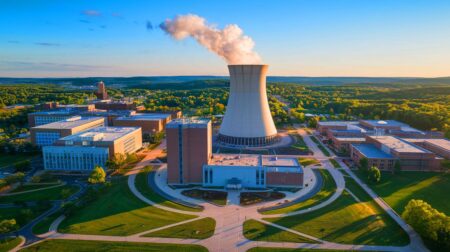As the economic powerhouse of Europe, Germany consumes a considerable amount of energy. The trouble is: much of it is generated by the burning of fossil fuels, with Clean Energy Wire finding mineral oil, natural gas, and coal collectively accounted for more than 80% of Germany’s primary consumption in 2016.
Headlines in January trumpeted renewables surpassing coal’s contribution to the electricity mix in 2018. This year as well Germany has generated 47% of its electricity in 2019 from renewable sources (counting biomass).
Those headlines, however, mask a stubborn reality. Last year mineral oil accounted for 34.3% of Germany’s primary energy, although most of it was used for transport fuels as opposed to power production. Gas followed with a share of 23.7%, making Germany, which imports 95% of the natural gas it consumes, the world’s biggest importer. The country also relies heavily on coal, especially lignite.
As the world’s largest producer of lignite, Germany extracts vast quantities of the substance (also known as brown coal) at opencast mines, with outputs amounting to more than 166 million tons in 2018 alone. While 47% of energy generation in 2019 may have come from renewables, it generated another 30.4% from coal and lignite.
Chancellor Angela Merkel’s government has pledged to shut down all the currently operating 84 coal-fired plants by 2038, but these power plants still account for 38% of the country’s domestic electricity production. This means that, for the time being, coal power continues to play a key role in Germany’s economy despite its much-touted Energiewende or “clean energy transformation.” New coal projects are also underway in locales like Datteln in North Rhine-Westphalia.
All the same, environmentalists have hailed the planned phase-out, which will cost an estimated $45 billion to mitigate the economic impact on the country’s mining regions. The decision is “a big moment for climate policy in Germany that could make the country a leader once again in fighting climate change,” said Claudia Kemfert, a professor of energy economics at the German Institute for Economic Research in Berlin.
Yet some prominent critics are questioning the way Merkel’s government is planning to go about phasing coal out of electricity generation. They are especially taking issue with the government’s stated intention to shut down all the country’s nuclear plants as well by 2022, a decision driven by popular fears regarding the safety of nuclear energy in the aftermath of the 2011 Fukushima incident in Japan.
Germany, a world leader on renewables, is banking on solar, wind and hydropower to keep growing and ultimately take the place of coal. However, critics like Volkswagen CEO Herbert Diess argue, the country won’t be able to make up for the shortfall in energy if the government takes both coal-fired and nuclear plants offline; nuclear still accounts for 13% of Germany’s electricity.
“If climate protection really matters to us, the nuclear power plants need to run longer,” stressed Diess, who leads Germany’s leading automaker. “The priorities are the wrong way round: first we need to get out of coal, and then out of nuclear power,” he added.
Klaus-Peter Willsch, an MP from Chancellor Merkel’s own Christian Democrat Party, seconded that sentiment. “Anyone who is in favor of low-carbon energy generation and guaranteed energy supply security cannot avoid nuclear energy,” Willsch was quoted as saying. “In terms of climate protection, nuclear energy is the cleanest way of generating energy,” he said.
Such views are in line with the International Energy Agency, which in a newly released report warns that shutdowns of nuclear plants in economies like Germany “could result in billions of tons of additional carbon emissions.” Merkel’s government has already been forced to concede Germany will not meet its 2020 emissions targets; the country essentially sacrificed a decade’s worth of emissions cuts, going from 908 million tons of CO2 in 2009 to 907 million tons in 2017.
The IEA’s findings warn specifically of the impact “nuclear fade” will have on the European Union, stating unequivocally that the loss of nuclear energy capacity will make clean energy transitions like Germany’s “more difficult and more expensive.” Whereas the EU had 125 GW of nuclear capacity in 2018, the report estimates it will have no more than 21 GW come 2040.
Germany’s tight spot over nuclear energy comes down primarily to domestic politics. Anti-nuclear sentiments, fueled in part by environmentalist groups like Greenpeace, has also impacted the country’s stance on nuclear plants in other parts of Europe. Berlin has notably teamed up with neighboring Austria to oppose nuclear initiatives in the Czech Republic.
Ironically, one of the byproducts of the 2011 decision to shutter German nuclear capacity was a spike in imported power from the same French and Czech facilities that German opponents of nuclear power have long wanted to see closed. It remains to be seen whether Germany’s 2038 coal phase-out can proceed without a similar spike in imported nuclear power, even if economics minister Peter Altmaier emphatically rejected the idea earlier this year.
As a global leader in advanced technologies, a more open-minded Germany would be ideally positioned to help Europe attain the greatest possible environmental benefit from safe nuclear power. Instead, with the fragile nature of coalition politics in Berlin making a rethink highly unlikely, the best Germany’s more nuclear-friendly neighbors can hope for is that the country will refrain from obstructing their own projects.
Did you like it? 4.6/5 (21)








